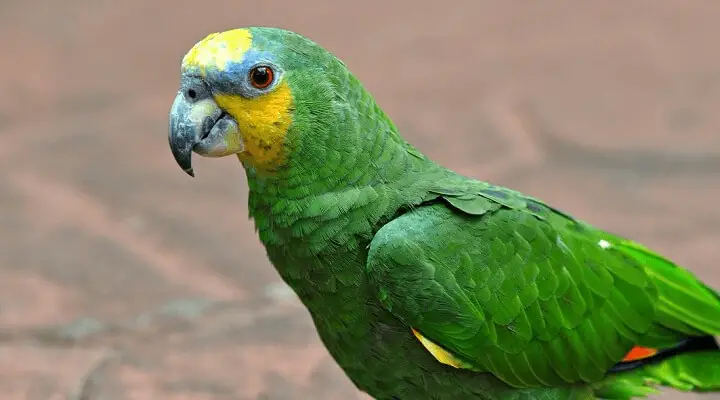
The Orange-winged amazon is a bird in the Psittacidae family. Its scientific name is Amazona Amazonica, is known in English as Amazon orange wing or Orange-winged Parrot.
It is popularly known as curica, aiurucatinga, ajurucatinga, ajurucuruca, green encounters, puffin parrot, kuritzaká, curau, parrot, curuca, and green encounters. Meet some more species of parrot
Distribution of Orange-winged amazon parrots
This species is found in the eastern Andes, Colombia, Venezuela, eastern Ecuador, eastern Peru, northern Bolivia, Brazil (Rio de Janeiro, São Paulo, in the forests and mangroves), French Guiana, and Suriname.
Its habitat preference is on coasts with mangrove formations. It also inhabits floodplains, flooded areas with a concentration of trees, fields, and tropical forests.
They are animals that adapt very well in homes and live with humans. Generally, even in the wild, they enjoy human presence.
Physical characteristics of the Orange-winged amazon parrot

orange winged amazon bird
The mangrove parrot is about 34 centimeters long and weighs about 340 grams. Its plumage is predominantly green. The tips of the nape feathers have a dark burgundy, the cheeks and the front of the head are yellow and usually, the forehead, the nostrils, and the area over the eyes are violet-blue.
The tips of the wings are yellowish-green, the primary feathers are green with nuances of violet-blue and the black tips, three secondary feathers are reddish in color, and the circle around the eyes is gray. The beak is gray with the tip almost black, the iris goes from yellow to orange and the feet are gray.
The adult males and females are identical, though the females are slightly smaller. In order to be sure of this bird’s sexuality it is necessary to carry out a DNA test.
Orange-winged amazon parrot feeding
The diet consists of fresh fruits such as bananas, acerola, jabuticaba, apples, guava, tangerines, oranges, papayas, and candied fruits without sugar. Berries, seeds, nuts, flowers, sprouts and green corn, sunflower seeds, pumpkin seeds, birdseed, rice in the husk, oats, millet, linseed, sprouted seeds, and vegetables such as carrots, broccoli, and cauliflower. Rice, cornmeal, soybean meal, boiled egg, flaxseed, oatmeal, beet pulp, and coconut oil.
Reproduction of the Orange-winged amazon parrot
This parrot is ready for mating at 3 years of age. The breeding period is from July to December. During this period the bird lands on high branches and begins to improvise a series of screams and whistles.
Usually, 2 to 3 eggs will be laid and incubated only by the female mangrove parrot, for about 28 to 29 days. The preferred place to make the nest is in hollow and thick trunks.
Generally, only a mangrove parrot chick usually survives childhood and leaves the nest at about 2 months of age. This bird is monogamous, and its fidelity is impressive.

Orange winged amazon parrot
Curiosities about the Orange-winged amazon parrot
The mangrove parrot usually flies with its peer and a few other individuals, seeking to locate food and enjoy it. At the end of the afternoon, they gather in a larger group, looking for a tall, leafy tree to protect themselves from predators and spend the night safely.
Orange-winged amazon parrot singing
The mangrove parrot speaks less than the true parrot, so it is not as popular as a pet. The vocalizations are softer and some of them are similar to those of the shellfish. The couple maintains contact through long shouts. Some individuals are noisy during flight and on resting trees, but when they are eating they are silent.
How to download or listen to Orange-winged amazon parrot songs
You can download the song of the mangrove amazon parrots on our website, to do this just right-click on the name of the song, then click on “Save Link As…” and choose the place where it will be saved. You can also listen, just click on the play button.
Orange Winged Amazon Friends
SOURCE:parrotsue
Orange-winged amazon parrot singing




















